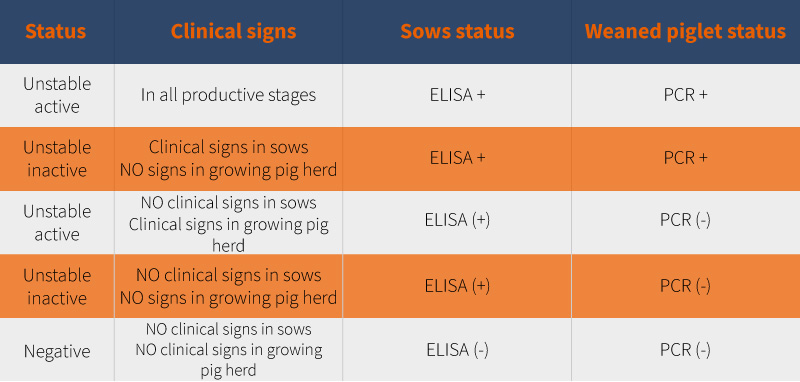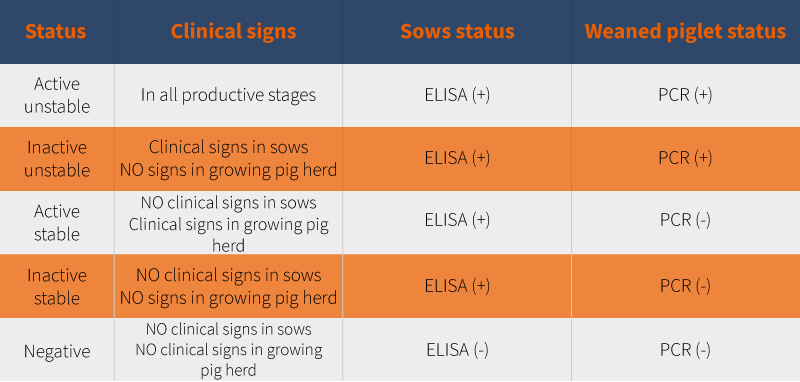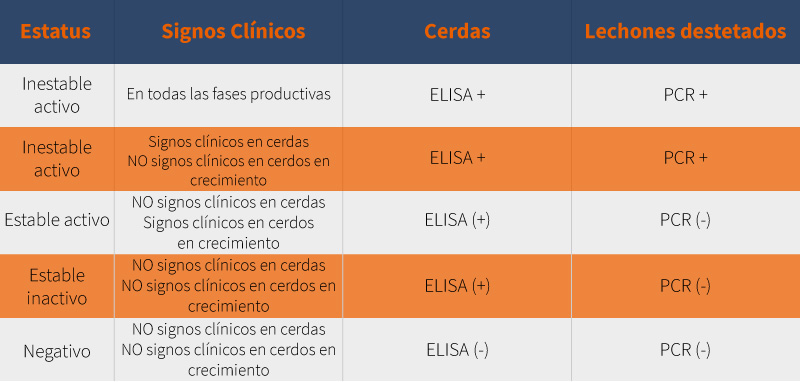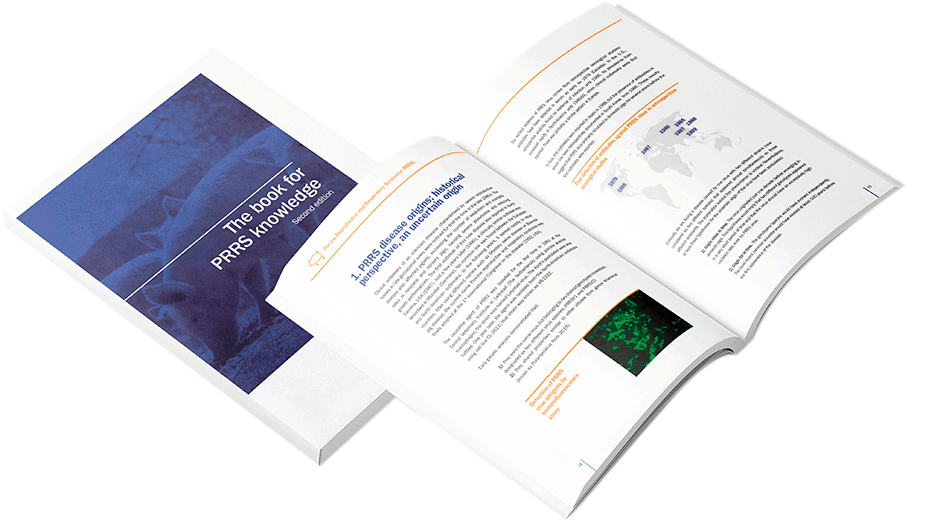Monitoring programs will differ depending on whether they are to be applied to a farm, an area, or a country, but I understand that in this case we are referring to a farm.
The program will vary depending on the type of farm and its disease status.
In the case of the PRRS, five possible statuses have been described:
What sample and technique should we use to check the PRRS status in a NEGATIVE farm?
To confirm a negative status, it would be enough to take 30 samples from breeding animals every quarter.
This sample size would allow us to detect at least one positive with a 10% prevalence and 95% confidence.
We are looking for the presence of antibodies, so an ELISA would be performed.
What sample and technique should we use to check the PRRS status in a POSITIVE farm?
With positive farms we are interested in getting them to the stable, inactive status, meaning that although they are positive, they produce negative piglets (PCR negative).
Phase 1 farms:
In this case, we would check the status of the breeding animals by taking 30 samples every quarter as in the previous case, but we are also interested in knowing the status of the piglets at weaning.
The sample size of the piglets at weaning could also be 30 serum samples, but we have to take into account that in those situations where we are trying to eliminate the disease from the production flow (especially in the final stages of the process) it is possible that we could have a prevalence lower than 10%, so in these cases it is common to increase the sample size to 60 samples (this would allow us to detect a prevalence of 5% or more). Samples should be taken monthly.
Phase 2 and 3 farms:
On nursery or grow-finish farms, serum or oral fluid samples could be taken 4 weeks after entry if barns are filled following an AIAO flow, or quarterly for continuous flows.
If serum samples are taken, 10-30 samples would be enough, and in the case of ropes we would place 1-4 for every 1,000 animals or per barn.
PCR would be done if the animals came from positive sows or ELISA could be performed if they came from negative sows.
If you want to know more about the PRRS monitoring in swine farms, please visit chapter “Diagnostic & Monitoring” of this site.
You can ask your own question! Visit Pig333.com and submit your question to the experts.
¿Cuál sería el protocolo para la vigilancia epidemiológica frente a PRRS?
Los programas de vigilancia serán distintos según se quieran a aplicar a una granja, zona o país, pero entiendo que en este caso nos referimos a una granja.
El programa variará según sea el tipo de granja y su estado respecto de la enfermedad.
En el caso del PRRS se han descrito 5 posibles estados:
¿Qué muestras y técnicas diagnósticas habría que usar para monitorear el estado de PRRS en una granja NEGATIVA?
Para la comprobación del estado de negatividad bastaría tomar 30 muestras de reproductoras cada trimestre.
Este tamaño muestral nos permitiría detectar al menos un positivo con una prevalencia del 10% y un 95% de confianza. Se buscaría la presencia de anticuerpos, por lo que se realizaría un ELISA.
¿Qué muestras y técnicas diagnósticas habría que usar para monitorear el estado de PRRS en una granja POSITIVA?
En el caso de granjas positivas nos interesa llevarlas al estado de estables inactivas, es decir, que siendo positivas produzcan lechones negativos (PCR negativos).
Granjas fase 1:
En este caso, comprobaríamos el estado de las reproductoras tomando 30 muestras cada trimestre como en el caso anterior, pero además nos interesa conocer el estado de los lechones al destete.
El tamaño de la muestra de lechones al destete podría ser también de 30 muestras de suero, pero hay que tener en cuenta que en aquellas situaciones en que se pretenda eliminar la enfermedad del flujo de producción (especialmente en las etapas finales del proceso) es posible que nos encontremos con prevalencias inferiores al 10% por lo que es común aumentar el tamaño de la muestra en esos casos a 60 muestras (permitiría detectar una prevalencia de 5%) o más.
La periodicidad de la toma de muestras debería ser mensual.
Granjas fase 2-3:
En granjas de transición (post-destete) o cebo se podrían tomar sueros o muestras de fluidos orales a las 4 semanas de la entrada (en caso de que se llenen siguiendo un manejo TD-TF) o trimestralmente, en caso de flujos continuos.
Si se toman sueros bastarían 10-30 muestras y en el caso de cuerdas colocaríamos 1-4 cuerdas cada 1000 animales o nave. Se llevarían a cabo PCR en caso de orígenes de cerdas positivas o podrían realizarse ELISA en caso de orígenes negativos.
Si deseas saber más sobre monitorización de PRRS en granjas porcinas, visita el capítulo “Diagnostic & Monitoring” de este sitio web.
Puedes formular tu propia pregunta! Visita 3tres3.com e introduce allí tu pregunta a los expertos.

Marcovetgrup S.L. – Spain






